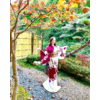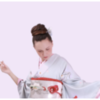- APR 9, 2022 10:07
A visit to Kimono town
Tokamachi has a unique history as a kimono and textile production town, being nationwide acclaimed as “Kimono town”, with its traditional dying practices and unique Kimonos.
- LIKE14
- 2687views
Did you know there is a Kimono town, hidden in the countryside of Japan, surrounded by big
mountain ranges and endless rice fields? Sounds like a fairytale place no?
About a year ago in summer my Kimono teachers invited me to visit that magical place.
As a Kimono seamstress I was very excited to join them on this trip. But where is Kimono
town? No, it is not Kyoto. The town is called Tokamachi , a small hidden gem in the country
of Japan usually covered in a thick blanket of snow every winter. It is not only famous for its
snow festival and the most snowfall in the world, it is known to be in the top 3 for largest
production and sales for Kimonos.
After a 3 hour ride in the car we made a stop in a famous Soba restaurant called Yoshia,
where the waitresses welcomed us in beautiful Kimonos. We tried the local specialty called
Hegi Soba served with regional fried vegetables. Sooo delicious!It is definitely worth to try
when visiting Tokamachi.
I could not wait resuming our trip further into the Kimono centre of the town. We hopped
into a few Kimono shops to inspect their gorgeous designs. It was a wonderful experience to feel the fabrics and to have my teachers explain everything I need to know about them.
Next stop was the sewing studio of my teacher Miyuki. I could observe experienced Kimono
Wasai (Kimono seamstresses) do their magic. They were all working on a different Kimono,
sewing them by hand without any use of machines. I was curious to see their traditional
sewing techniques. Some of them were the same ones I was being taught in my school and
some of them were new to me. It was amazing to meet and talk with people who share the
same passion for kimono making and to show them the Kimonos I was working on myself.
I didn’t know then that the best part of this trip was yet to come.
Tokamachi has a 1300 year long history of textile manufacture and the most famous there is
Aoyagi. Founded in 1938 the factory creates their Kimonos completely in-house, using
traditional methods of weaving, dyeing, Shibori and Yuzen.
A friendly guide led us through the rooms where we witnessed artisans dye the fabric with
the Kata Yuzen (stencil dying) technique. As I was learning more on the tour I understood
how rare and precious Kimonos are, especially since only a handful of people were working
there. They are not just producing beautiful Kimonos, they also educate the public by
offering workshops in Shibori and Yuzen dyeing.
Before returning back to Tokyo I had the privilege to enter a store that can only be visited by
Kimono professionals. But it wasn’t a regular Kimono store; it was a Kimono treasure vault.
The Kimonos there were the kind of Kimonos I have never seen before, not even in museum
exhibitions. All one-of-a-kind pieces with prizes so high that they are hardly affordable. They
were made with beautiful embroideries and elaborate motifs showing landscapes or even
exotic patterns.
My favorite Kimono in the collection was made by using the rare Oborozome-Kasane
Shibori. It is a dyeing method in which the Top of the Kimono is darkened and gradually
blurred toward the hem. The patterns are created using the Yuzen technique and Shibori.
with small Embroidery details. Oborozome is a highly skilled craftsmanship which requires
many steps and time.
After a few fittings at the store my day at Tokamachi came to an end and I had to hop on
the train heading back to Tokyo and leaving all those beautiful Kimonos behind.
I'm hoping to learn more about the Oborozome method in the future when visiting Kimono
town again.







posted by
- Hi! My Name is Sabrina Gross and I‘m a Kimono Designer from Europe.
Tags
You May Also Like
-
How I started my Kimono journey in Tokyo and created my first handsewn Kimono within 6 months.
- Sabikimono
- 2717views
-
Makeup Artist Paladini PePe About Special Effect Makeup, the Future of Beauty, and Sadako
Whether it be photo shootings or film sets, they are a true master of their craft, and behind ...
- WAi! WAi! JAPAN
- 5290views
-
JLPT Needs to Change, and Here Is Why
The Japanese Language Proficiency Test is the most widely used Japanese language ability tests...
- WAi! WAi! JAPAN
- 5744views
-
5 Underrated Shrines and Temples in Tokyo and Japan
Five of the most underrated holy places in Tokyo. A must visit for people who cannot get enoug...
- WAi! WAi! JAPAN
- 6179views
-
4 Calm and Harmonious Shrines and Temples in Tokyo and Japan
A list of holy places in Japan's capital Tokyo, not only rich in history and culture, but also...
- WAi! WAi! JAPAN
- 3541views















